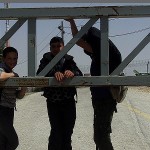
Filmed and produced by Cat Rabenstine for the Christian Peacemaker Teams in Palestine.
Life in the West Bank

Filmed and produced by Cat Rabenstine for the Christian Peacemaker Teams in Palestine.
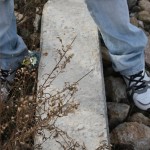
Today I took a walk through a friend’s village near Bethlehem. The sky was blue and spotted with clouds. It was chilly but the sun peaked through with surprising radiance.
First, he (let’s call him Ahmed) showed me a 4×4 inch cement track that follows one entire length of the village, coming within yards of the school. This tiny bit of cement will, maybe within the year, become part of The Wall built by Israel in this case to separate their settlement from the Palestinian village nearby.
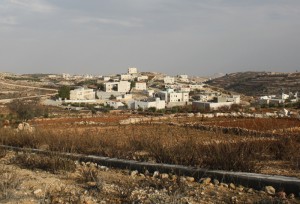
We walked up a dirt road to two demolished houses, the foundation of one home holding the remains of its former walls. The army demolished the houses, saying they posed a security threat. One family lived in a tent for a few months before building a new house.
Standing on top of the rubble, I saw the huge Israeli settlement homes looming above on the highest, closest hill. The houses looked huge and stable, capped with the ubiquitous red roof, a characteristic of Israeli settlement buildings.
We retraced our steps and walked the other way towards the paved settler-road to take pictures of the village from above.
The entire time we walked, the cement track followed us. Ahmed stood with each foot on either side of it, “One day, my left foot won’t be allowed in this spot,†he said.

He hesitated for just a second before we had walked up this hill. He wasn’t supposed to walk on it. He said, “If soldiers come, they all know me by name. We will just run to the Palestinian side.â€
Once we reached the top of the hill, Ahmed pointed to three Israeli security cameras. All were pointed at us.
Each time I hear a story like Ahmed’s: homes demolished, livelihood wrecked, school children at risk, land taken, I consider my own family.
If it were my mother’s home being demolished or my brother being harassed daily by soldiers younger than him who haphazardly tote machine guns at their side, I’m not sure how I would react.
Would I try to defend them with violence?
Would I become depressed and feel hopeless?
Would I write about my situation, try to tell the world my story?
I don’t know what I would do, and I believe no one should have to answer this question. But I do know hundreds of Palestinians who have to respond to this question daily.
To read how “Ahmed†and his village have responded, click here.
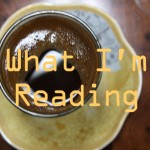
BY: Mkhaimar Abusada for Bitter Lemons
The Arab Peace Initiative, which was adopted by the Arab League at its summit meeting in Beirut in 2002, is a comprehensive peace initiative first proposed by then-Crown Prince Abdullah of Saudi Arabia, and re-endorsed at the Riyadh summit in 2007. The initiative attempts to end the Arab-Israel conflict, which means normalizing relations between the entire Arab region and Israel in exchange for a complete Israeli withdrawal from all Arab territories occupied in June 1967 and a “just solution” of the Palestinian refugee problem based on UN Resolution 194.
One of the main elements of the Arab initiative stipulates: “The acceptance of the establishment of a sovereign independent Palestinian state on the Palestinian territories occupied since the 4th of June 1967 in the West Bank and Gaza Strip, with East Jerusalem as its capital.”
The issue of sovereignty and independence is of great interest and importance to Palestinians. They have not experienced independence or sovereignty in modern history. After World War I, Palestine fell under the British Mandate until 1948, and then Israel controlled 78 percent of mandatory Palestine. The West Bank was then annexed by Jordan, and Gaza was administered by Egypt, both until 1967. As a result of the June 1967 war, Palestinians in the West Bank and Gaza have been living under Israeli occupation.
The Oslo accords, signed in September 1993, led to the creation of the Palestinian Authority over parts of the West Bank and Gaza. They have deprived Palestinians of any elements of sovereignty or independence and kept the PA under total Israeli control. Palestinian movement from and into the PA territories is subject to Israeli approval. Commercial exports and imports are also subject to Israeli laws and regulations according to the Paris Economic Protocol.
“Sovereignty”, according to the Encyclopedia Britannica, is the quality of having supreme, independent authority over a geographic area, such as a territory. The concept has been discussed and debated throughout history, from the time of the Romans through to the present day, where the notion of globalization has motivated new debates. Although the term has changed in its definition, concept and application, the current notion of state sovereignty is often traced back to the Treaty of Westphalia (1648), which, in relation to states, codified the basic principles of territorial integrity, border inviolability and supremacy of the state. A sovereign is the supreme lawmaking authority within its jurisdiction.
Sovereignty means the right of the state of Palestine to become a full member of the United Nations General Assembly, adopt the UN charter, and conform to international law, the Universal Declaration of Human Rights and all other related UN documents. The state of Palestine will also be subject to its own constitution and legal norms.
“Sovereignty” for Palestinians means a total end to the Israeli occupation of the West Bank, Gaza Strip and East Jerusalem. It means that Palestinians alone will control their territory, air space, electromagnetic field and water within their own territory. It means the ability to enact laws and implement them over its citizens.
It also means the right of the Palestinian state to form its army and national security to defend territorial integrity and borders. It means the ability to defend the territory from outside enemies and aggression. But Palestine will not need to enter into military alliances, an act that violates the terms of peace and normalization with Israel.
Sovereign Palestine means the right to establish and conduct foreign and diplomatic relations with other countries to pursue peace and prosperity. No country can live in isolation from the community of nations. Countries cooperate in political, economic, security and cultural aspects, and Palestine shall be given the right to develop and pursue its diplomatic relations with Arab and Islamic–as well as western–countries.
It also means Palestine’s ability to administer and oversee the holy sites within its territory. Palestine is home to the three major religions, thus requiring it to respect and protect Jews, Christians and Muslims. Religious sites, especially those in East Jerusalem and Bethlehem, must be accessed by their respective observers. Palestine must establish a ministry to preach peace, tolerance and acceptance among all people.
Sovereign and independent Palestine will not live in a vacuum. It will be part of the community of nations that respects international law and human rights, and will do all it takes to pursue peace, security and prosperity in the region.
–Published 5/1/2011 © bitterlemons- api.org
Mkhaimar Abusada is a professor of political science at Al-Azhar university, Gaza.

CPTnet Digest
4 January 2011
A newsletter written by members of Christian Peacemaker Teams and Operation Dove.
Operation Dove (Nonviolent Peace Corps of Association “Comunit” Papa Giovanni XXIII) and Christian Peacemaker Teams (CPT) announce the publication of the 2009-2010 report on the Israeli military escort to the Palestinian schoolchildren from the villages of Tuba and Maghayir al-Abeed.
An average of eighteen Palestinian children from the villages of Tuba and Maghayir al Abeed attend school in the neighbouring village of At-Tuwani.
To reach school, the children typically use the primary road that connects their villages with At-Tuwani and passes between the Israeli settlement of Ma’on and the Israeli outpost of Havat Ma’on (Hill 833).
Since 2001, Israeli settlers from Havat Ma’on have routinely attacked the children on their journey to and from school, but it was not until November 2004 that Israeli authorities established a daily military escort.
Despite the Israeli military escort, the children have been victims of violence 104 times between November 2004 and June 2010.
The soldiers carrying out the escort have at times failed to protect the children and have frequently arrived late, causing the children to wait, sometimes for hours, before and after school.
During the 2009-2010 school year, children missed almost twenty-seven hours of school and waited fifty-three hours for military escort after school.
In addition, the soldiers regularly failed to provide a complete escort of the children, almost always leaving the children to walk unescorted beside settlement buildings, in an area where settlers have attacked them.
Despite the children’s right to access education, the military fails to provide a consistent escort for the children. When the military does not arrive, the schoolchildren must take alternative routes that take up to two hours by foot through a rocky, hilly landscape. Furthermore, settlers attack the children and their relatives on these longer paths.
Members of Operation Dove and Christian Peacemaker Teams have had a continuous presence in the village of At-Tuwani since 2004 and daily monitor the military escort of the schoolchildren.
The report, “The Dangerous Road to Education. Palestinian Students Suffer Under Settler Violence and Military Negligence” is available as a PDF. Click here for the PDF document.

Palestine Today: A Reality of Justice Denied
Media with Conscience
On December 24, Mondoweiss co-editor Adam Horowitz wrote:
“Israeli military kills 20-year old Gazan for herding animals too close to buffer zone.”
On December 23, Israeli forces shot and killed Salama Abu Harhish without warning while herding sheep and goats in Beit Lahya. Civilized nations don’t murder nonviolent civilians in cold blood, this time leaving a widow and day-old unnamed baby.
What “democracy” thrives on violence, spurns peace, and wages preemptive wars like Cast Lead. Besides America, only Israel, a global menace like its Washington paymaster/partner, together with Britain the real axis of evil.
Commemorating Operation Cast Lead in Gaza
The Palestine Telegraph
Gaza, (Pal Telegraph) – A demonstration commemorating the beginning of “Operation Cast Lead†was held Tuesday in the Gazan city of Beit Hanoun. Families of victims were in attendance, as were 5 International Solidarity Movement activists. Two years have passed since the Israeli attacks on Gaza, which killed over 1400 people in just 23 days. The vast majority of victims were civilians, including 350 children, according to the United Nations and other major human rights organizations.
The Local Initiative demonstration began at the railway street in Beit Hanoun, near some of the most horrendous attacks which occurred during the land, air and sea bombardment of Gaza. The group of around 40 continued into the ‘buffer zone’ to within 100m of the Israeli border, holding flags and photos of children killed two years ago. During the 23-day attack, none of Gaza’s 1.5 million inhabitants (including 800,000 children) were safe.
In Bethlehem, shepherds watching their flocks by night are a dying breed
The Guardian
If an “angel of the Lord” were to appear in the sky over Bethlehem today, there would be scarcely any shepherds keeping watch over their flocks to witness the scene.
Spending nights and days in the fields herding sheep has become an almost impossible task for the fast-diminishing community of shepherds in this biblical Palestinian town.
Jewish settlements, Israeli army checkpoints, closed military zones and the West Bank separation barrier have reduced the grazing area to such an extent that a growing number of Bethlehem shepherds have been forced to give up their traditional livelihoods. “I miss the freedom of the wilderness. Everything is different now. We can barely move,” says Adel Alsir, a 35-year-old Palestinian who herds his flock less than 100 metres from a biblical site known as the shepherds’ fields.
On Palestine, the US is a rogue state
The Guardian
On 17 December, Bolivia extended diplomatic recognition to the state of Palestine within its full pre-1967 borders (all of the Gaza Strip and the West Bank, including East Jerusalem). Coming soon after the similar recognitions by Brazil and Argentina, Bolivia’s recognition brought to 106 the number of UN member states recognising the state of Palestine, whose independence was proclaimed on 15 November, 1988.
While still under foreign belligerent occupation, the state of Palestine possesses all the customary international law criteria for sovereign statehood. No portion of its territory is recognised by any other country (other than Israel) as any other country’s sovereign territory and, indeed, Israel has only asserted sovereignty over a small portion of its territory – expanded East Jerusalem – leaving sovereignty over the rest both literally and legally uncontested.
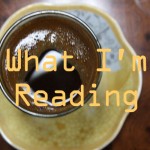
Published in The Nation
Christopher Hayes | October 14, 2010
Hebron
The first thing you notice when you drive into Hebron is the lack of cars. Since 1997 this second-largest Palestinian city in the West Bank, the only one with an Israeli settlement in its midst, has been formally divided. Within the Israeli section, which takes up much of the historic downtown, Palestinians are not allowed to drive, so they walk or use donkey carts. When people are ill or injured, they are carried to the hospital. It is not surprising, therefore, that many of the 30,000 Palestinians who once lived here have moved out. According to a 2007 report from Israeli human rights organizations, more than 1,000 Palestinian housing units in the area have been left vacant, and more than 75 percent of the businesses in the central district have closed. A handful of shops remain open; a cluster or two of children play in the street. But that’s it. The streets are buried under the heaviness of an ominous quiet. Periodically, buses rumble past bringing settlers to and from the adjoining settlement, Kiryat Arba, and Israel proper. In the absence of routine urban noise, their engines sound like gunshots.
I went to Israel and the West Bank with a group of American journalists on a trip sponsored by the New America Foundation. We were led through the streets of Hebron by Mikhael Manekin, a former Israel Defense Forces soldier who patrolled the city during the second intifada. He now runs an organization called Breaking the Silence, which collects testimony about IDF human rights abuses from Israeli soldiers. I had heard of Hebron, of course, but it was lodged vaguely in my mind as one of those foreign places where awful things happen. To see it in person is to understand viscerally that the status quo in the West Bank cannot hold. To see it is to understand just what occupation requires.
Because of the Cave of the Patriarchs—where Abraham is said to have buried his wife and was later laid to rest—Hebron is a very holy site for Jews and Muslims. Hebron’s long history has been one of occupation and coexistence, punctuated by periods of slaughter. Romans, Crusaders and Ottomans have all ruled the city, sometimes denying access to the holy sites to disfavored groups. In 1929 Arab rioters killed sixty-seven of the small number of Jewish residents of the city (several hundred were saved by their Arab neighbors, who hid them in their homes), and the last Jewish resident left the city in 1948. In 1968, just a year after Israel occupied Hebron, Rabbi Moshe Levinger, a spiritual founder of the settler movement, traveled with a few students to the city for Passover. Once there, they refused to leave, extracting a concession from the Labor government at the time to settle them in the adjacent army base of Kiryat Arba, which today is a settlement of 7,200.
In 1979 ten women and forty children from Kiryat Arba sneaked into the abandoned Jewish hospital in downtown Hebron under cover of night and also refused to leave. Over the next fifteen years, they were joined by hundreds of other settlers—men, women and children—drawn from the most zealous, who came to inhabit the surrounding buildings.
Over the past three decades, violence has been a mainstay. In 1980 Palestinians killed six yeshiva students in the city center. In 1988 Levinger shot and killed a Palestinian store owner, pleaded guilty to negligent homicide and served thirteen weeks in prison. In 1994 Baruch Goldstein, from Kiryat Arba, entered the mosque at the Cave of the Patriarchs and murdered twenty-nine Muslim worshipers before he was overcome and killed. The IDF imposed near total curfews on area Palestinians.
Then, in 1997, as part of the Oslo peace process, security control over Hebron was divided. Palestinian Hebron, now home to some 170,000, fell under the jurisdiction of the Palestinian Authority and became known as H1. The section dominated by Israeli settlers remained under IDF control and became known as H2. There are 800 Israeli citizens who live in H2, with 500 IDF soldiers to guard them.
Within its jurisdiction, the IDF enforces a policy it calls “separation,” which has a renewed urgency in the wake of the second intifada. A three-foot concrete barrier runs down the main street of the downtown, creating a small shoulder where Palestinians may walk; Israelis pass on the other side. A few blocks farther on, an Israeli soldier and a flag on a rooftop herald the beginning of the zone the army calls “fully sterilized,” meaning no Palestinians. A young merchant hawking bracelets followed our group, entreating us to buy a souvenir. He stopped short, as if running into a glass wall, the moment we hit the outpost.
It felt as if we were walking through a postapocalyptic urban video game brought to life. The old Hebron gold market sat empty and trashed, every shop door was shuttered, graffiti was scrawled over much of the area. Eight Israeli soldiers with flak jackets and machine guns marched slowly past in formation, making their regular patrol through the deserted streets. A police car began to tail us, since Mikhael has been assaulted by settlers while leading people through the neighborhood.
In the courtyard outside the main settlers’ apartment complex, a group of boys played soccer in a lot sandwiched between a large recycling bin half full of plastic bottles and a sign that read, in part: This land was stolen by arabs following the murder of 67 hebron jews in 1929. We demand justice! Return our property to us! Women in head wraps and long skirts pushed strollers; men walked past with shopping bags. Though they live inside a heavily militarized garrison, they can walk the empty streets as if in a European pedestrian mall.
Around the corner, on Shuhada Street, are the last Palestinian holdouts in the neighborhood. They occupy second-floor apartments with balconies covered in metal braces and chicken wire. Because the street is closed to Palestinians, the residents of these caged apartments are not allowed to use their front doors; at those rare times when they leave to get provisions they must go out via the roof or makeshift doors.
As we reached the limits of H2, past graffiti of Stars of David and the slogan For every settlement evacuated, we will kill 100 Arabs, we arrived at an Israeli checkpoint, a small wooden shack manned by a few soldiers. Mikhael told us that as an Israeli, he couldn’t go through but urged us to do so. As if passing through a magic portal, we emerged on the other side into the honking, bustling chaos of a living city: shops selling T-shirts and DVDs, shopkeepers smoking cigarettes and shouting to one another over the noise, commuters hailing cabs and pedestrians dodging snarled traffic. And then, back through the magic door and into the deathly silence of occupied Hebron.
There, while settlers routinely harass Palestinian residents and the tension sometimes erupts into violence, the IDF has succeeded in its immediate goal of avoiding large-scale bloodshed. This has come, however, at the cost of turning a holy city into a moral obscenity. One might be tempted to dismiss Hebron as unique, but Mikhael insists it’s only a matter of degree rather than kind. “This is the same policy all over the West Bank,” he says. “Separation, militarization, patrol roads. In rural areas it looks a lot nicer, but it’s no different.”
At a lunch earlier that day, a prominent member of the Yesha Council, the organizing body for the settler movement, told us his “conscience is clear” about Israeli settlement and the occupation of the West Bank. But after the tour of Hebron, our bus driver, who hadn’t been to the West Bank since serving there in the 1967 war, looked at us as we boarded the bus and said, “As an Israeli, I am shocked.”
Before long, Israelis may not have to travel to Hebron to see what full-spectrum urban occupation looks like. In recent years, the most ideological of the settler organizations have, with government help, stepped up efforts to “Judaize” East Jerusalem, to make it far more difficult to incorporate into a Palestinian state, should that day arrive.
Things are especially tense in the East Jerusalem neighborhood of Silwan, where settlers have purchased apartment complexes and number about 500, dotted among 60,000 Palestinians. In September a private Israeli security guard shot and killed a Palestinian father of five named Samer Sirhan. The guard claimed he was faced with a life-threatening ambush from which he had to shoot his way out, but witnesses and security camera footage contradicted his account. The police accepted the guard’s version, and no charges were filed. Since then there’s been an escalation of rock-throwing at the settlers, and settlers have called for a heavier police presence and more security. On the day we toured East Jerusalem, the head of the Silwan settlers, David Be’eri, ran over two Palestinian boys after his car was targeted by rock-throwers. Many people told us that if there is a third intifada, it will start in Silwan.
In the East Jerusalem neighborhood of Sheikh Jarrah, another settler group has used a few Ottoman-era land deeds and the power of the state to evict fifty-three Palestinians from their homes—which their families had moved to after being expelled in 1948 from their original homes in present-day Israel. The evictions have been denounced by everyone from Hillary Clinton to Israeli author David Grossman and have sparked a weekly protest that every Friday draws many Israelis to the only municipal park in East Jerusalem. But so far, despite legal appeals, the settlers remain in the houses.
There is a pointed irony in the settlers using pre-1948 deeds to make their case for occupying the homes in Sheikh Jarrah: it is usually Palestinians, demanding their right of return, who argue that pre-1948 deeds are legitimate. “From a Zionist perspective, it’s suicide,” activist and writer Didi Remez says about these settlers. “What they’re trying to do is bring Hebron to Jerusalem.” God help us if they succeed.
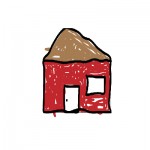
This year wasn’t my first Thanksgiving abroad, a holiday that is oh-so-North-American that celebrations overseas usually take on a little local flavor. In Kerala, India we were treated to curried barbeque chicken and the most delicious mashed potatoes I may ever taste. I wore a navy blue churidar to that meal. In Dublin, our Irish hosts had a special meal cooked up for our group of college students on a social justice study trip. We arrived after dark and left patches of snow on the carpeted stairs as we tromped up to the second floor, where we ate family-style. In Rome, I wore chic black and ate Chinese food at a restaurant in Monte Mario. Each time, the food was warm and delicious and I felt thankful to be among friends thoughtful enough to make Thanksgiving part of their week.
This year I celebrated Thanksgiving with hummus and pita in Bethlehem, Palestine while my Mom and younger brother made prime rib and Yorkshire pudding in Madison, WI. They probably talked about his latest rugby game and her projects at work and their upcoming trip to the Holy Land for Christmas. Pete fixed a few things in the house and carried the water softener salt to the basement while Mom set the table with festive placemats and a bouquet of enormous sunflowers. It probably smelled like slowly cooking meat and the house felt warm and cozy, at least in the rooms where Mom didn’t close the vents to save energy. Van Morrison probably crooned on speakers throughout the house. They might have remembered little Briggs, the ancient cat who blessed my family with her tiny presence from my childhood into my young adulthood. Though her little legs were atrophied in old age, she continued to launch herself with reckless abandon over sofas and between our legs, and proceed to sleep for hours with the same reckless abandon that got her to her latest perch.
Thanksgiving, even more than Christmas, is a time when going home is about just that – going home. There aren’t gifts or mad shopping-sprees to make you sweat with pressure. It’s a time to cook extravagantly and eat American-ly, and then sleep with the reckless abandon only possibly during a long weekend.
Once I left home for college, returning home make me conscious of what it felt like to be home, something I had taken for granted when I was always there. I realized that it smelled like detergent and wood and a constantly brewing pot of Red Rose tea. Mom would make up my bedroom with clean sheets, often placing a small vase of fresh flowers on my nightstand. I’d return to school realizing that no, I wasn’t actually Buddhist, and the guy I was dating was a materialistic yahoo and that I should take an afternoon and go to the Art Institute to absorb inspiration and realize my vast potential.
Home, no matter where you are, is a place of rejuvenation and encouragement, solace and stability, family and peace. When I asked friends what home means for them, whether American or Palestinian, their responses were fed with the same nourishing sentiments.
“Home is safe, caring, giving and can be anywhere as long as it’s a place where one can feel alive.â€
“There is a song that says that home is where I’m loved, which is turning out to be the most true definition of home for me. Until I reach my own definition of the physical meaning of the home, I would say that my home is the virtual space where I’m comfortable. It could be a nice gathering in the evening or it could be a sweet late phone call with someone you love.”
“A place to be carefree without worries. Being with family. The only door that is always open when other doors are closed. Home is a place where one finds peace, solitude, serenity, tranquility and enjoys his time regardless of how trivial his lifestyle is, he still finds it to be sublime.â€
“Home equals warmth, love and encouragement. It’s where you can just be you.â€
“Home is where the heart is and where you make it a place of welcome. It is a place where family and friends can come any time…and there will be food.”
Home is hardly ever about the actual structure, it’s about the feelings you have when you are there. That is, until the structure itself is at risk.
My apartment in the West Bank is within spitting distance of The Wall near Rachel’s Tomb. When I look out my bedroom window, I see it wrapping around the other side of my building, up the hill next to Aida Refugee Camp. Heavy cement blocks soar up to 25-feet-tall with metal fencing on top, the kind that protects innocent outsiders from dangerous prisoners inside (I’m on the inside). I have three bedrooms, two bathrooms, a huge kitchen and a living room that seats nine because the family that used to live here moved out when The Wall was built. Their store on the first floor failed because the street was difficult for shoppers to access and their view was, suddenly, demoralizing rather than breathtaking.
Fear and resignation are emotions I don’t relate to when I think of my home, but for some of my Palestinian friends this is their reality at home.
Once, I was invited to dinner during Ramadan at a friend’s house in a village called Sarra, situated near Nablus on the top of a hill and surrounded by Israeli settlements on all sides. As we walked through the village, my friend expressed pride in the beauty of her neighborhood. She pointed to her house from far away, “That is my home.â€
The house was gorgeous, with a special room for the eldest daughter to teach English to kids in the village. The three daughters shared a pink bedroom. Her father, a taxi driver, came home just for dinner and then returned to work until nearly midnight. He cracked jokes and his daughters poked fun at him during dinner. He fed his wife a piece of bread with a look of admiration and adoration on his face. He made the best of the few minutes he had with his loved ones, relaxing in the home he created with them.
We sat on their porch to eat, sitting elbow to elbow on a mat that wrapped us around the generous meal. In the distance, I noticed a growing flame. Olive trees were on fire. I looked around at the family members when we all noticed and saw on their faces something frightening, resignation. They were so accustomed to watching their land burn, that they were resigned to it. We watched an Israeli army jeep drive past the fire, doing nothing about the huge flames burning innocent olive trees, the crops and livelihood of Sarra villagers. We continued to eat as the land burned.
Yesterday I visited Wadi Rahal, a beautiful village nestled among sloping hills and surrounded by olive trees just a few kilometers from Bethlehem. We drove the winding path from route 60 to the village, the foundation of The Wall followed us. When built, The Wall will separate the village from its own olive trees. It will sit 10 meters from the village’s one school. It will cut off the village from the highway. I met with two college students, both activists doing their best organize weekly demonstrations and train the village in non-violent ways to resist The Wall.
They said that, about twice a month, Israeli soldiers enter one of the homes in the village in the middle of the night to do a search. They use the butt of their machine guns to bang on the door. If it isn’t opened in time, they break down the door. They wake up the entire family and search the entire house, breaking dishes and wreaking havoc. One of the guys said if he hears any noise at night he believes it is the army and it scares him. His home does not feel safe.
Each Thanksgiving, many recognize that the holiday symbolizes a loss of land and livelihood for one group of people and the victory of another. While I stare at The Wall from my kitchen window, I think about my neighbors in Aida Refugee Camp, who were kicked out of their homes in 1948 so that Israeli families could have a homeland. I am thankful that during my Thanksgiving dinners at home, I have never looked out the window to see our trees burning down. I am thankful that I can sleep, with reckless abandon, after a huge turkey (or prime rib) meal, knowing that I don’t need to feel scared. My home smells like detergent and wood and Red Rose tea, and I’m not afraid of losing it.
Most of the time I feel that the conflict for a home in Israel and Palestine is too complicated to ever truly grasp, but sometimes, like on Thanksgiving, it seems pretty simple.